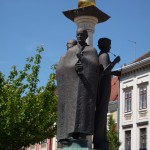-
Recent Posts
- CLLEAR seminar Friday 6th October: Prof Tania Ionin 26/09/2017
- TNS Workshop 6th July 19/06/2017
- CLLEAR Thurs 25th May @ 4pm: Prof Jennifer Smith and Dr Sophie Holmes-Elliot 22/05/2017
- CLLEAR Seminar Wednesday 17th May: Prof Alessandro Benati 11/05/2017
- CLLEAR Seminar Friday 5th May: Dr Neal Snape 27/04/2017
Archives
Exploring Central Europe – migration and multilingualism
 Where is central Europe? This might sound a strange question but answering it is not as straightforward as you might think.
Where is central Europe? This might sound a strange question but answering it is not as straightforward as you might think.
My colleague Jenny Carl and I were intrigued by Stanisław Mucha’s 2004 documentary film Die Mitte (The Centre), in which he travels the length and breadth of Europe in search of an answer to a related but rather different question: where is the centre of Europe? The upshot of Mucha’s bizarre, meandering journey was that this apparently very particular location is everywhere and nowhere, or rather perhaps that it’s where you want it to be: he found contenders scattered across no fewer than six countries.
The point, of course, is that neither ‘the centre of Europe’ nor ‘central Europe’ can be tied down definitively to a place on a map. These are contentious issues that social historians and political scientists have endlessly debated. And it doesn’t only depend on who you ask but on when you ask: the shape and extent of ‘central Europe’ have fluctuated across time as a result of military conflicts, colonial expansion and cultural shifts. One of the enduring effects of these complex historical processes was the creation of a highly multilingual space, straddling the borders of nation states that defined themselves as resolutely monolingual.
Which is where we came in. We were attracted by the ambiguities that characterize the elusive idea of ‘central Europe’ and wanted to explore them from a linguistic perspective. We particularly wanted to investigate the tangled relationships between the various ‘national’ languages in the region and German, which over centuries has played several different roles: dominant language of politically powerful nation states and empires, medium of cultural expression and lingua franca across many neighbouring states, language of oppression, and language of marginalised minorities.
 In our project, which was funded for 3 years by the AHRC, we aimed to understand the dynamics of language and social change in central Europe in the context of the end of the Cold War and the eastern expansion of the European Union. Our findings have been published in the monograph Language and Social Change in Central Europe (Edinburgh University Press) and in Language, Discourse and Identity in Central Europe (Palgrave), a collection of studies together with other researchers exploring the idea of central Europe as a multilingual space. More information on the project can be found on the website www.glipp.soton.ac.uk
In our project, which was funded for 3 years by the AHRC, we aimed to understand the dynamics of language and social change in central Europe in the context of the end of the Cold War and the eastern expansion of the European Union. Our findings have been published in the monograph Language and Social Change in Central Europe (Edinburgh University Press) and in Language, Discourse and Identity in Central Europe (Palgrave), a collection of studies together with other researchers exploring the idea of central Europe as a multilingual space. More information on the project can be found on the website www.glipp.soton.ac.uk
Since completing this project, I have embarked on a new study of migration and multilingualism, shifting the focus of my research to the multilingual metropolis Berlin. The aim here is to investigate the reciprocal effects on individual biographies of different patterns of migration and encounters with different languages. Here, too, I will bring together political discourses on language and personal narratives in a historical account of language and the city.
A first flavour of this project can be found in the essay ‘SprachGeschichten mit Migrationshintergrund: demografische und biografische Perspektiven auf Sprachkenntnisse und Spracherleben’, published in Arnulf Deppermann (ed.) (2012) Das Deutsch der Migranten (Berlin, New York: de Gruyter), pp. 193-222.
